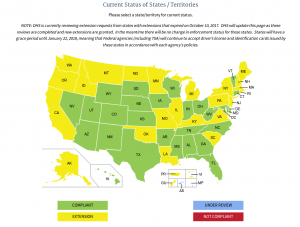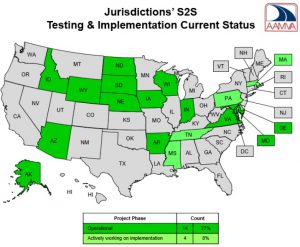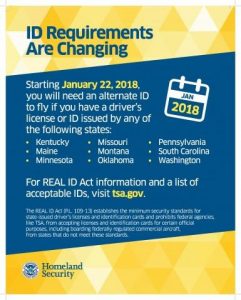We’ve been spending a lot of our time lately writing letters to the editor pointing out errors and requesting corrections of news stories reporting DHS propaganda as fact.
Earlier this month, the DHS postponed from January 22, 2018, to October 10, 2018, the date on which it had threatened to have the TSA begin (illegally) interfering with air travel by residents of certain states. Since neither the January 22, 2018, date nor the choice of which states to threaten was set by law or regulation, but solely by DHS press release, the DHS could and did withdraw its threat merely by issuing another press release.
The DHS had little choice, after its bluff was called by reality (compliance with the REAL-ID Act would require more money, more time, and changes to state laws and in some states including California, changes to state constitutions) and the likelihood of resistance by the flying public (any attempt to prevent residents of certain states from flying without ID would lead to protests at airports and lawsuits that the TSA and DHS would likely lose).
But we are not surprised, given the long history of DHS lies about the REAL-ID Act and ID to fly, that the DHS press release withdrawing the threat of a January 22, 2018, crackdown on air travel without ID by residents of certain states was immediately followed by a renewed DHS public relations campaign of lies about the law and the facts.
DHS press releases should no more be published as “facts” without fact-checking or acknowledgment that they contain contested (and readily refuted) factual and legal claims than should President Trump’s, President Obama’s, or anyone else’s Tweets.
The New York Times is the latest news outlet to have been taken in, yet again, by this DHS “fake news” campaign, with an article this week on the Times’ website and in the travel section, “Is Your ID Approved for Travel? These Are the Latest Rules“. Many of the DHS falsehoods in this article were reported as facts in an earlier story in the Times in November, 2017, by the same reporter, Shivani Vora. We wrote to Ms. Vora at that time to correct the errors in that story, but received no reply.
To be clear, DHS claims are worthy of reporting as news. It is newsworthy that the DHS has engaged in a decade-long campaign, through both Democratic and Republican Administrations, of brazen public lies about the REAL-ID Act and ID to fly.
It is equally newsworthy, however, that a “newspaper of record” appears to have made no attempt to fact-check the claims made by DHS spokespeople or to include any other points of view, and repeats demonstrably false DHS claims as undisputed facts even after their falsehood was pointed out to the reporter on the story.
Specifically, the latest article in the New York Times reports the following DHS “fake news” as fact: Read More →


